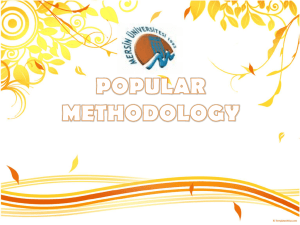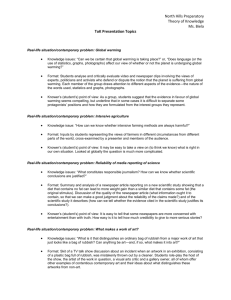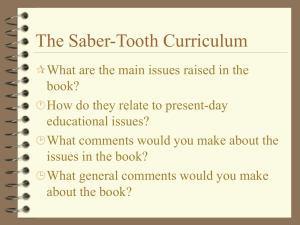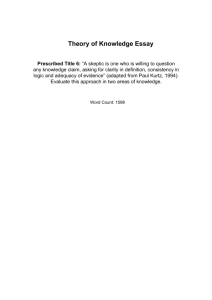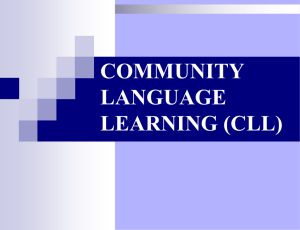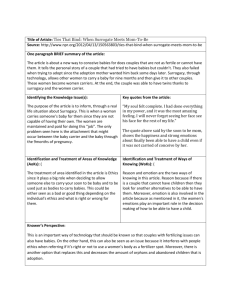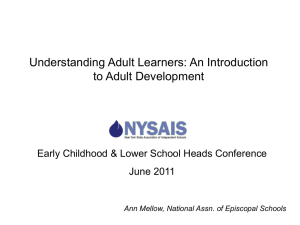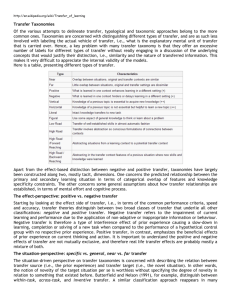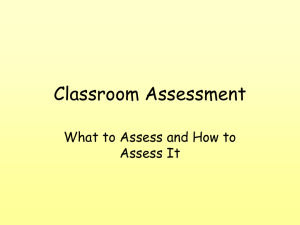MS Word - Web Science Repository
advertisement
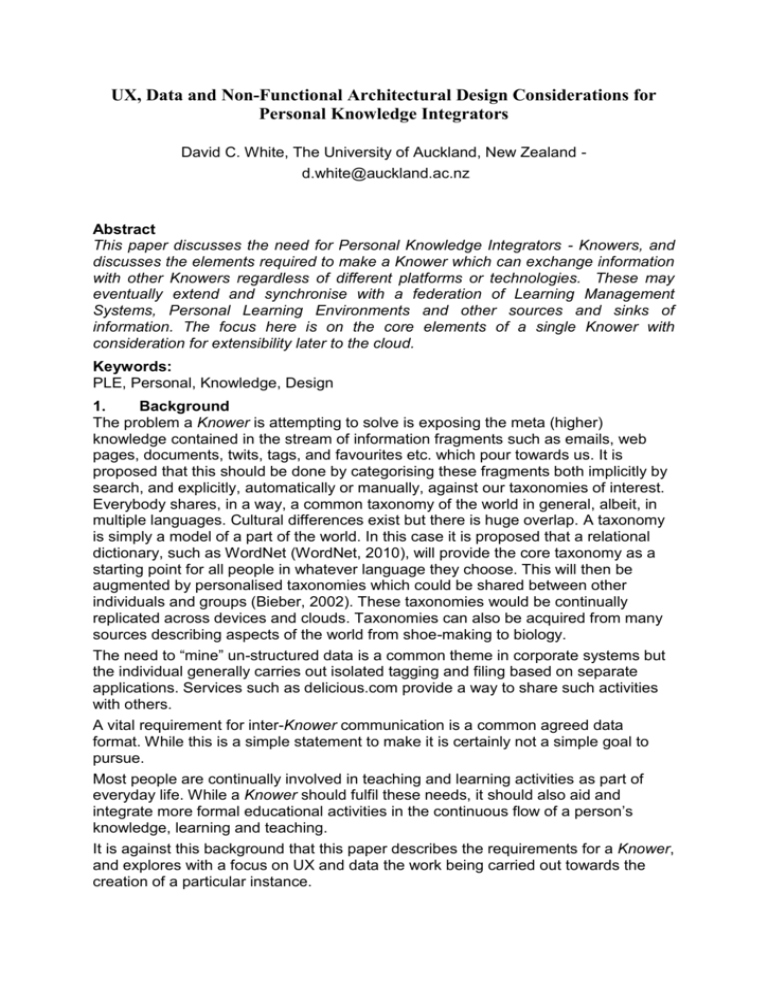
UX, Data and Non-Functional Architectural Design Considerations for Personal Knowledge Integrators David C. White, The University of Auckland, New Zealand d.white@auckland.ac.nz Abstract This paper discusses the need for Personal Knowledge Integrators - Knowers, and discusses the elements required to make a Knower which can exchange information with other Knowers regardless of different platforms or technologies. These may eventually extend and synchronise with a federation of Learning Management Systems, Personal Learning Environments and other sources and sinks of information. The focus here is on the core elements of a single Knower with consideration for extensibility later to the cloud. Keywords: PLE, Personal, Knowledge, Design 1. Background The problem a Knower is attempting to solve is exposing the meta (higher) knowledge contained in the stream of information fragments such as emails, web pages, documents, twits, tags, and favourites etc. which pour towards us. It is proposed that this should be done by categorising these fragments both implicitly by search, and explicitly, automatically or manually, against our taxonomies of interest. Everybody shares, in a way, a common taxonomy of the world in general, albeit, in multiple languages. Cultural differences exist but there is huge overlap. A taxonomy is simply a model of a part of the world. In this case it is proposed that a relational dictionary, such as WordNet (WordNet, 2010), will provide the core taxonomy as a starting point for all people in whatever language they choose. This will then be augmented by personalised taxonomies which could be shared between other individuals and groups (Bieber, 2002). These taxonomies would be continually replicated across devices and clouds. Taxonomies can also be acquired from many sources describing aspects of the world from shoe-making to biology. The need to “mine” un-structured data is a common theme in corporate systems but the individual generally carries out isolated tagging and filing based on separate applications. Services such as delicious.com provide a way to share such activities with others. A vital requirement for inter-Knower communication is a common agreed data format. While this is a simple statement to make it is certainly not a simple goal to pursue. Most people are continually involved in teaching and learning activities as part of everyday life. While a Knower should fulfil these needs, it should also aid and integrate more formal educational activities in the continuous flow of a person’s knowledge, learning and teaching. It is against this background that this paper describes the requirements for a Knower, and explores with a focus on UX and data the work being carried out towards the creation of a particular instance. 2. A Knower in a Personal Learning Environment As a person in the centre of a PLE what I and many others lack is the ability to coordinate and comprehend the variety of data flowing towards us. We all attempt to manage this to some extent by filing in directories, tagging and social bookmarking but every tool we add to our arsenal seems to require us to repeat data and/or process. Fig. 2.1 Elgg Personal Learning Environment The design described in this paper is not a PLE but a Personal Knowledge Integrator (PKI), the hub of a PLE. I have given this class of tool the name Knower (White, 2010), and the particular instance I am describing, Noah. Stephen Downes, in his diagram of a PLE (Downes S., 2006), shows a hint of a Knower. Elgg as shown in David Tosh’s PLE diagram (2010) is also performing the function of a Knower but in a centralised system. In Tosh’s PLE diagram Fig 2.1 I would suggest the personal file repository is the place a Knower would slot in. Or simply taking Elgg and making it personal would make it a Knower. The data model of Elgg is an excellent starting point for the design of a Knower and could be the basis for a standard. 3. Scenarios to articulate the requirements of a Knower 3.1 The Teacher/Student It is the case that everyone is a learner and most are teachers. We all gather and collate information which hopefully illuminates us and becomes knowledge. In the context of formal education we are all aware of the need for both teachers and learners to manage the resources and activities throughout the education process. What much of this interchange, known as teaching and learning, requires to give it cohesion are taxonomies on which to focus and interlink the resources and activities of the process. 3.2 The Grandfather’s Legacy Ali is a grandfather who is contemplating what he leaves behind for his grandchildren as a trace of a life. In his study he has an array of objects which represent moments gathered along the path. But what would they mean to those who find them? A note could be attached to each. Also he has disks filled with writings and images from scanners and cameras from a long digital life. As he reflects he sees a timeline on which all these elements sit, often in multiple places referencing when they were created, when acquired, the geography of their past, and the keywords and notes which link into the personal taxonomic fingerprint which describes his life. The clay figurine brought from India by his great-grandfather speaks of this. It was made in a time and place by someone, acquired and then been passed from hand to hand through generations. It is in this context that its value can be understood, especially in regard to his forever relationship with his ancestors and descendants. He wants to turn this into an archive which can be passed on and extended by future generations. The family tree, in itself a taxonomy created through many hours of research by his sister, waits be incorporated into this evolving story. 3.3 The Artists Diary Jessica, a young landscape designer/artist from a pacific island has just returned from creating a garden at the Chelsea Flower Show, winning a medal, meeting the Queen of England, going to the top of a chimney at the Battersea Power Station, and other intense experiences. She exclaims in her bubbling enthusiasm that what she wants is an artist’s diary, a digital one, to write in, to paste images into, and to keep special emails, sketches, sound notes, video clips, her children’s paintings. To be able to create views distilled and selected from her gatherings of digital moss. She is frustrated as she cannot see and share all the treasures which are buried in her computer, her mobile, back-up drives, and cloud storage. 3.4 The History Teacher Mr King, a history teacher has discovered a wonderful resource which is a data feed providing historical dates and associated geo-locations for a variety of events. He sees this as a way to provide his students with a context of both time and place as they prepare essays and projects. He wants the students to build a common resource of images, references linked into their own work, held together by the string of time, the planes of space and the network of knowledge. As well as the simple time-based events of this first data source he continues to find others such as records of climate, finances, and wartime casualties which he would like to incorporate into his teaching. When students create their own assignments these would become more relevant when integrated into the shared data and resources of the world. If his students have already studied the ecology of a region they should see this merged with their historical studies of the same region. 3.5 The Protectors of the Maui’s Dolphins The Protectors of the Maui’s Dolphins wish to manage the information they gather about these endangered creatures which live in a few isolated locations around the South Island of Aoteoroa, New Zealand. It is imperative that all sightings are recorded along with imagery which can be used to identify the individuals and their families. These observations come from professional and amateur marine biologists, from fishermen and from the general public both from on-shore and at sea. Anybody is able to send in images, video and audio recordings, and of course, simple sightings. These are all then classified using biological taxonomies, family trees, space and time. As well, other streams of data showing pollution levels, sea and air temperature can be placed alongside the observations allowing correlations to be detected and explored in the hope of improving the chances of survival of these creatures. To engage the providers of the information will be reflected. Back in geospatial linked to a timeline. 4. What then is a Knower? The function of a Knower is to connect, coordinate and present diverse data which may then be better able to be coalesced into knowledge in our minds. A Knower’s aim is to increase the value of the information wealth available to an individual first and groups secondly. A Knower aims to make knowledge more digestible, through context and cross-reference. A Knower will aid the digestion of information and then present it in visualisations as food for the mind to become knowledge. A Knower will consist of 3 elements, interfaces to data sources and sinks, a data store/cache and many interactive visually rich user experiences Fig. 4.1 A Personal Knowledge Integrator in the context of a PLE When we look at the current environments in which we live our digital lives we see, be it in Windows, Apple or Linux a focus on applications which operate on files stored in a file system. On mobile devices we see seas of icons which act on independent stores of data. In Windows Phone 7 there is a hint of a new phenomenon, a focus on data with applications as simply views onto a shared store. The UX of a Knower should provide illumination to this clutter. By creating Knowers we are proposing to give coherence to an individual’s information/knowledge space to bind disparate data sources together and to do this using taxonomies, both independently articulated and derived from the analysis of an individual’s knowledge assets. 4.1 A Knower’s Data Interfaces These will be RSS feeds, application API’s, web services, the structure of an individual’s file system, the contents of files, lists of favourites stored by browsers and other data sources and sinks. Modules of this type will allow the user to plug into many common services such as learning management systems, Flickr, WordPress, Google, Windows Live and delicious. 4.1.1 “Real” Data Feeds From a knowledge integration perspective we move to another level of potential when we consider that we have access to an exponentially increasing amount of “real” data via sources utilizing standards such as ODATA (ODATA). Instead of consuming data embedded in textural pages, we can consume data streams as if from a database. Let me illustrate this with an example. At present I am watching a video “First Life” presented by David Attenborough which describes evidence about the emergence of life both geographically and over time. Mention is made of the geological eras Cenozoic, Mesozoic etc. Because my knowledge of these is sketchy, to say the least I have to go and consult another source and then put the two together. Soon we will have access to the raw data about these events and will be able to merge the “new” data from the article I am reading with data from other sources to produce insightful visualisations. Already In my Knower data may be stored from a previous study of tectonic plate movement. Thus, as new knowledge is acquired it can be shown beside previous knowledge enhancing, through context, known and potential relationships. This shift from a page to a data focus will allow the emergence of whole new dimensions of knowledge expression (data mash-ups) including visualisations, animations and simulations. A primary design requirement of a Knower is to allow this to be achieved by anyone. 4.2 Knower Data Model The data model design is the core element of a Knower where standardization must be considered to allow interoperability between different instances of Knowers. In all the work over the years on standards for learning management systems, learning objects etc., much is known about the data exchange requirements to support teaching, learning and knowledge management . It is also important that this data can be synchronised across Knowers and devices. The Elgg data model is a good starting point as it has adopted a very generalised structure which encourages extensibility. The Elgg model shows great promise over other data store designs. It is a type of Knower, albeit a centralised one. Fig. 4.2 Elgg Data Motel 4.2.1 Knower Taxonomy Taxonomies are key elements of the data structures required, the essential spine of a Knower. Taxonomies must be able to evolve and merge with their more informal relative, the folksonomy. Fig. 4.3 All Roads Lead to “Philosophy” A person’s taxonomy can be derived in part from and will be synchronised with existing data such as categories of favourites, folders of emails and disk directories. Also in the future use will be made of search and text analysis to augment and weave taxonomies from stored resources. Each person’s individual collection of taxonomic terms represents their fingerprint of knowledge. As we create and extend our personal taxonomies, we will be able to share them with others. Taxonomies will come from collections of taxonomies such as schema.org and other specialised sources. The power of textual analysis to derive taxonomies can be seen in Fig 4.3 which shows a graph illustrating, how, from an analysis of Wikipedia, everything leads back to philosophy. Metadata, by definition, is "data about data". Metadata of a document can be its author, format, creation date and location -- all relatively simple to determine. It can also be information about the document's content such as tags, keywords and taxonomy entries, or names of mentioned people, organizations and locations. This kind of metadata helps greatly when narrowing down the search results; however it requires much effort when entering it by hand. To extract such data all textual information entering a Knower will be passed through a classification engine such as Pingar (Pingar, 2011). Taxonomies are available commercially and in the public domain describing many subject areas. The most general taxonomy of all is our language which is available via WordNet (Miller, 1995) and it is planned to integrate this into a Knower. A good source of taxonomies is http://schema.org/. “Knowledge was once an internal property of a person, and focus on the task at hand could be imposed externally but with the Internet, knowledge can be supplied externally but focus must be forced internally” (Stanger, 2010). It is through the lens of taxonomy that a Knower will provide this focus. Taxonomy will create a “topic map” type layer over all the resources being received by the Knower. Basically everything that is seen by a person or processed through their electronic devices will be seen by the Knower and then illuminated by automatic tagging based on text analysis and predefined but evolving taxonomies. Manual classification will of course also be possible as will manual adjustment to auto-classification. Work on Digital Object Identifier’s (The DOI® Handbook 2005) must also be considered in this design. 4.3 Knower User Experiences Fig. 4.4 Elements flow into a person’s digital space and are automatically classified Fig. 4.5 Categorized nuggets after classification are projected onto knowledge and geographic taxonomies The user interface of a Knower is where we should see the maximum variety and innovation thus it is essential that the software architecture be modular and flexible. Many projections of Knower data are possible one of which is shown above in Fig. 4.4 and Fig 4.5 This shows information landing in a person’s digital space, being processed by a taxonomy classifier and then referencing a taxonomy to the top in Fig 4.5 as a traditional tree and to the right into a map space. There are a large variety of contextual spaces and forms into which the data of the Knower can be projected into 3D and is an on-going area of research. 5. Non-functional Architecture of a Knower A Knower will exist in the current and emergent information architecture of the cloud and mobiles. Fig. 5.1 A Knower with mobile and cloud The points listed below are inherent in this architecture. Must support virtually all electronic devices used by the person to collect, exchange and consume information Data stored in an accessible format so tool-lock in does not occur Devices may be lost so should synchronise with on-line storage Allow both automatic and manual classification On-line storage to allow access from non-specific devices 6. Description of the approach used The work is being carried out by constructing prototypes using the Agile methodology. Evaluation is via constant user feedback into the next design/implementation cycle. The framework of Noah, our instance of a Knower is based on the Prism Composite Application Framework for Microsoft Silverlight and the Managed Extensibility Framework (MEF). These frameworks allow for a plug-in architecture at either source code or binary level. 7. Conclusions From the illustrative scenarios described there certainly seems to be a need for Knowers and there will already be many incipient Knowers that people have created in response to this obvious need. It will, I am sure, be an area of fruitful development in the next few years as we learn to cope with the richness of Personal Knowledge Environments and how they can be enhanced using Knowers. To enable the interchange of data clear standards are required, probably already emerging in corporate knowledge management and other fields. 8. References All Roads Lead to “Philosophy” http://www.xefer.com/ Bieber, Michael, Im, Il, Rice, Ronald E., Goldman-Segall, Ricki, Paul, Ravi, Stohr, Edward A., Hiltz, Starr Roxanne, Preece, Jennifer J. and Turoff, Murray (2002): Towards Knowledge-Sharing and Learning in Virtual Professional Communities. In: HICSS 2002 2002. p. 213. Downes S., 2006, www.halfanhour.blogspot.com/2006/10/ple-diagram.html Edtechpost, 2008-2009, A Collection of PLE diagrams, edtechpost.wikispaces.com David Tosh, 2010, ELGG a PLE - http://tesl-ej.org/ej34/m1.html David Tosh, 2007-2011, Elgg Educause 2009, 7 things you should know about Personal Learning Environments Gardner, L., White, D., Sheridan, D., 2002, A web-based learning and assessment system to support flexible education, Journal of Computer Assisted Learning, Vol 18, No. 2, 2002, 125 - 136. Miller, G. A., 1995. WordNet: A Lexical Database for English.Communications of the ACM Vol. 38, No. 11: 39-41. Nunamaker, J.F., Chen, M., and Purdin, T.D.M. 1991. Systems Development in Information Systems Research, Journal of Management Information Systems (7:3), pp 89-106. ODATA, Open Data Protocol, Pingar, http://www.pingar.com/ Stanger, L. 2010 Individual Knowledge in the Internet. Educause Review March/April 2010, p.16 The DOI® Handbook, 2005 http://www.doi.org/handbook_2000/DOIHandbook-v42.pdf Uren, V., Cimiano, P., Iria, J., Handschuh, S., Vargas-Vera, M., Motta, E., Ciravegna ,F. 2006, Semantic annotation for knowledge management: Requirements and a survey of the state of the art, Journal of Web Semantics White, D.C., 2010, PLE2010 Design and Implementation of a Personal Knowledge Integrator Federated with Personal Learning Environments White, D., Coromandel, M., Sheridan, D., 2010 A video annotation tool for personal and collaborative use
